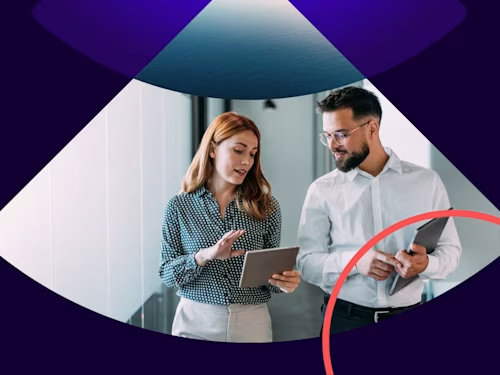
Docusign eWitness: our guide to electronic witnessing
Docusign eWitness allows you to simply sign and witness an agreement. Read on for an overview of what it is and answers to frequently asked questions.
Table of contents

Everything you need to know about electronic witnessing
Documents and deeds can easily be signed and witnessed electronically with Docusign eWitness. Does your company need electronic witnessing? Electronic witnessing solutions have long been required by legal teams, clients and witnesses to avoid lengthy delays to contracts via the post. Read on to discover an overview of eWitness and get your questions answered.
eWitness allows you to add an electronic signature and act as a witness for an agreement or deed in a simple way. This electronic practice avoids the costs, errors, and time associated with manual witnessing. Electronic witnessing can ensure that contracts get executed quickly even when the person authorised to witness on behalf of an individual, company, or companies is not physically present. Here we give you an overview of what Docusign eWitness is and answer your questions about the electronic witnessing of agreements.
Q: What is Docusign eWitness?
Docusign eWitness is a feature of Docusign eSignature that allows organisations in the UK to enable signers to identify up to two witnesses to sign an agreement or deed simply and electronically. Docusign eWitness provides solutions for signing and witnessing documents and deeds, for many cases, including for property with HM Land Registry deeds.
Docusign eWitness captures the witness transaction details in the Certificate of Completion to provide a record of which party signed and who witnessed the signature process. This certificate is downloadable - so it's easy to get a copy that can serve as necessary evidence of signing and witnessing statements. It includes the address, email address, IP address and time stamps of the signing and witnessing parties.
Q: What customer problem does Docusign eWitness solve?
Historically, a "wet-ink" signature was the only option for witnessing a signature in the UK. Manually capturing witness information is often slow, time-consuming and costly, requiring the printing and posting of documents. Now a document can be signed using an electronic signature and electronic witnessing.
Q: What are the benefits of Docusign eWitness?
There are many benefits to using Docusign eWitness:
It's flexible and easy to use
It's flexible, easily configurable and easy to use for all parties, including senders, signers and witnesses.
Accelerate agreement completion
Digitising manual, and paper-based processes speeds up the contracting process and lets you get documents signed and witnessed faster.
Reduced Risk
The Docusign eSignature Platform is secure and provides the flexibility to choose between witnessed electronic signatures or digital signatures, including Advanced and Qualified signatures (AES and QES) that require identity verification and authentication before a digital certificate is issued. Docusign eWitness supports a second factor of authentication with a one-time password, delivered by text message for both the signer and the witness.
Capture court-admissible evidence
The Certificate of Completion provided with eWitness captures key detailed information about signers and witnesses such as IP addresses and time stamps. This information can often help provide evidence for the transaction in the event of a legal dispute.
Save time and money
Avoid the costs, errors, and time associated with manual witnessing.
Q: Can you add multiple witnesses?
Yes, a Docusign envelope can include both witnesses and regular recipients, and customers can set the signing order to create a workflow for their Envelopes. Currently, there is a cap of two witnesses per signer.
Q: Can Docusign eWitness be used to "witness" a signature from a different location to the signatory?
The Law Commission's September 2019 report on the electronic execution of documents (2019 Law Commission Report) concluded that deeds could be signed and witnessed using an electronic signature platform. The view of the Law Commission (and of the Law Society in a June 2020 update ) is that where there is a legal requirement for a signature on a document to be witnessed, the witness must be in the physical presence of the signatory and directly observe the signatory signing.
It is up to the sender to ensure that the signer and witness are co-located.
Docusign captures details such as IP address and geo-localisation (based on consent from the signer and witness) to indicate that both the signer and the witness are in the same location and complete at the same time.
Q: What are some key use cases for using Docusign eWitness?
Docusign eWitness can be used in a multitude of scenarios and use cases ranging from Real Estate to Financial Services and Legal Firms. However, it is up to each organisation and the individual to ensure that Docusign eWitness meets its specific requirements and regulations. The eWitness feature is a game-changer for the typical real estate lawyer whose documents are often registrable at the Land Registry. Discover more about electronic witnessing with HM Land Registry.
Q: How do I add this feature to my account?
Some advanced features and options are supported only in certain Docusign eSignature plans. The eWitness feature is considered an Advanced Solution. Please contact your Account Manager or contact sales.
FAQs
In summary: how does Docusign work for electronic witnessing?
An electronic signature can be witnessed like a wet ink signature, a witness who is physically present can observe a signatory adding their signature to a document electronically. Docusign eWitness captures the witness transaction details in a Certificate of Completion which provides an electronic record of who signed and who witnessed the signing process.
How to use electronic signature for legal documents?
Electronic signatures are legally binding and can be used for legal documents. England, Wales and Northern Ireland have legally recognised electronic signatures since 2002. Read on to discover how to electronically sign a document. Some types of legal documents require a witness to be physically present with the signer that they're witnessing for. This is when it's useful to use the Docusign eWitness feature of Docusign eSignature.
How can I start with electronic witnessing with Docusign?
Docusign eWitness is an advanced feature of Docusign eSignature, the #1 way to send and sign documents electronically. It's easy to configure and use for all parties, including senders, signers and witnesses. If you already use Docusign eSignature, please contact your Account Manager to understand how you can get started with electronic witnessing with Docusign.
Related posts
Docusign IAM is the agreement platform your business needs



